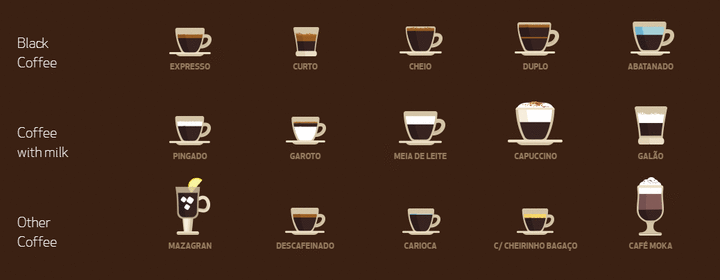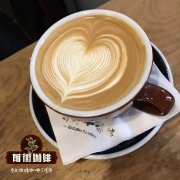How would you like your Portuguese coffee? Coffee drink finishing in Portugal

Professional coffee knowledge exchange more coffee bean information please follow the coffee workshop (Wechat official account cafe_style)
[culture] the Portuguese are not joking with you about "coffee"--
The history of coffee drinking in Portugal can be traced back to the 18th century, when the colony of Brazil produced coffee, and Portugal was once the largest coffee producer in the world. In addition to Brazil, former Portuguese colonies such as East Timor (Timor), Sao Tome and Principe (S ã o Tomé e pr í ncipe) and Angola (Angola) also produce coffee beans, which gives Portuguese blended coffee a unique style and is roasted at low temperatures in the process, with lower acidity and retaining the original flavor of more coffee. I don't know much about coffee, but at least compared with the sour coffee in many cafes in Paris, France, I think Portugal tastes too good! Portuguese coffee powder is also a good souvenir / companion gift.
More than 80% of Portuguese drink coffee every day, with an average of 2.5 cups a day, that is, almost in the morning, midday and evening. Coffee shops in almost all parts of Portugal are three steps to a small home, five steps to a large degree, and you can drink fresh and good coffee anytime and anywhere. It is worth mentioning that a large number of Portuguese do not drink coffee at home, drinking coffee is not only an eating habit, but also a part of social activities. Even if they eat at home, many Portuguese like to go out and have coffee in a coffee shop near their home after dinner.
There are many kinds of coffee drinks in Portugal. Here are some common ones:
1) Caf é or Caf é expresso: the most common point method, also known as Bica in Lisbon and Cimbalino in Porto. This is a Portuguese version of expresso that is larger than the Italian version and is usually drunk after meals.
Why the coffee é in the Lisbon area is also called Bica, there is an interesting story: at A Brasileira, a Brazilian cafe in the center of the city, because it is a bit painful to see customers drinking bitter coffee, they put up a sign that reads "Beba Isto Com A coffee host car" (drink this with sugar--), and the initials of the four words become BICA.
2) Caf é curto or Italiana: it is a little more curto than Caf é, that is, the degree of espresso.
3) Caf é cheio: the opposite of Caf é curto, coffee is lighter than normal Caf é.
4) Duplo: two cups of Caf é are poured into the same cup.
5) Abatanado: there is a slight controversy on the definition, some are equivalent to Duplo with a little water, and some are Caf é cheio with a little more water, which is lighter than Caf é.
6) Pingado: add a little cold milk to the cafe.
7) Garoto: the opposite of Pingado, heat the milk on Caf é curto or Caf é, or add milk foam.
8) Meia de Leite: literally "half milk", which is the latte we are familiar with.
9) Gal ã o: most of the time it is equivalent to Meia de Leite, and it can be divided into Gal ã o claro (less coffee) and Gal ã o escuro (more coffee) according to personal preference, which will be filled in a larger glass, usually in breakfast and afternoon tea.
10) Carioca: secondary Caf é filtered from coffee powder that has been used once, usually very light. Carioca de lim ã o is tea made with lemon peel in hot water, which has nothing to do with Carioca.
11) Caf é com cheirinho: it's Caf é with a little call and a little aguardente or other spirits, usually after dinner.
12) caf é sem princ í pio: avoid the Caf é (more caffeine) that comes out of the machine at the beginning, and the taste will be lighter.
13) Mazagran: Caf é poured on ice, often with mint leaves.
14) Descafe í nado: remove caffeine from Caf é.
These coffees are usually served with one or two packets of sugar, depending on your taste.
END
Important Notice :
前街咖啡 FrontStreet Coffee has moved to new addredd:
FrontStreet Coffee Address: 315,Donghua East Road,GuangZhou
Tel:020 38364473
- Prev

Have you ever had a real mocha? the difference between Yemeni mocha and mocha?
More information about coffee beans Please follow Coffee Workshop (Wechat official account cafe_style) Coffee originated in Ethiopia, which is located in the highlands of East Africa, and has been producing high-grade Karabica hand-dried coffee beans, named after Gudu Hara, for nearly 2000 years. More than 1500 years ago, coffee trees were introduced to Yemen on the other side of the Red Sea
- Next

How to identify coffee beans in the sun and washed in water? is Ethiopian Yega Xuefei Coffee delicious?
Professional barista communication Please pay attention to the coffee workshop (Wechat official account cafe_style) there are many ways to handle coffee beans, which will affect the aroma of coffee. The following are two common ways of tanning and washing: 1. Solarization: after the coffee fruit is picked, pick out the immature fruit and miscellaneous leaves, directly expose the coffee fruit to the sun for 2 weeks, except after drying
Related
- How did the Salvadoran coffee industry develop in Central America?
- What exactly does the golden cup extraction of coffee mean?
- The Origin of Coffee flower
- [2023 Starbucks World Earth Day] there are more meaningful things besides free Starbucks coffee!
- What kind of coffee is there in Spain? 9 Flavors of Spanish Coffee
- Aromatic African coffee| Kenya's coffee culture and historical production area
- Liberica Coffee Bean knowledge: the characteristics of Liberian Coffee beans of the three original species of Coffee beans
- The origin and formula of Spanish latte introduces the taste characteristics of Bombon coffee in Valencia, Spain.
- How to adjust the solution of over-extracted coffee
- What is the tasting period of coffee beans? What is the period of coffee and beans? How should coffee wake up and raise beans?

